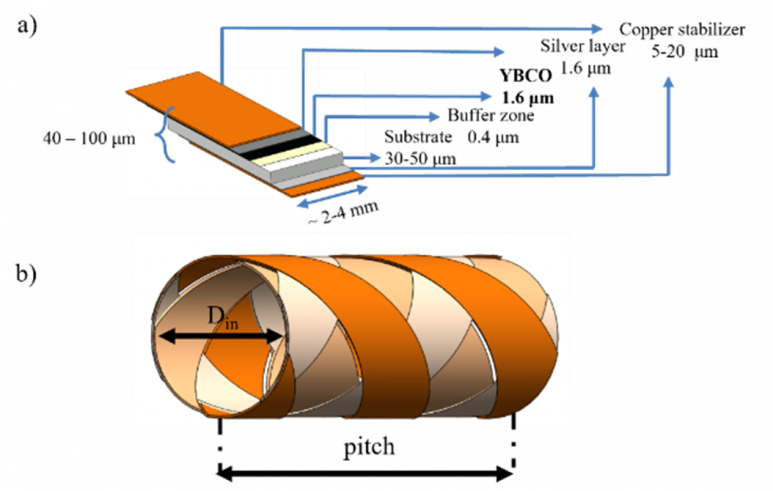Multiphysics analisys for superconducting cables
Activity carried out in the framework of Sofia Viarengo's PhD (tutored by Prof. Laura Savoldi) in collaboration with Prof. Fabio Freschi.
Objective of the activity: Development of multiphysics (thermal and electromagnetic) models for High temperature superconducting cable for fusion and accelerators applications.
Framework of the activity:
The aim of the activity is the development of a multi-physics electromagnetic and thermal model of high temperature superconductors (HTS) for canted cosine theta magnets (CCT) applications. In the framework of high-field low inductance superconducting magnets for particle accelerators, CCT represent a viable design for high energy physics and hadron-therapy applications, particularly relevant for strain sensitive superconductors, as HTS, as Bi2212 and REBCO, see Figure 1 a). With the perspective of reaching 20 T field levels and satisfying the requirements of high operating currents and compact coil layouts, the Conductor-On-Round-Core (CORC) cable, see Figure 1 b), can be a promising option, due to its round cross-section, its electrical and mechanical isotropy. Concurrently with a dedicated experimental characterization of the critical current, it is important to develop numerical models capable of replicating and eventually predicting cable performance. This will allow for quantifying the degradation caused by both the winding process and operating conditions. A new multi-physics numerical model for the characterization of the critical current (Ic) of the REBCO CORC® cable is proposed for that activity, implemented with the commercial software COMSOL Multiphysics. A multi-scale approach is followed: firstly, the identification of a proper formulation for the electrodynamic modelling, suitably coupled with a thermal model, has been addressed for a single tape. Then, it was extended to the CORC® wire. Taking advantage of high tapes aspect ratio, a thin shell approximation has been exploited: the model is based on the hybrid T-A formulation, for the electric magnetic module, coupled to a heat conduction equation for thin shell. The model (2D and 3D) of the single tape has been validated through experiments carried out at LBNL: it consists of the tape, immersed in a bath of liquid nitrogen at 77 K, in which the current is injected into to evaluate the characteristic VI curve. In the fully 3D CORC® model, a new boundary condition has been implemented which allow the current redistribution of the current among different tapes and layers. The model for CORC® cable is still under validation with respect experimental data, whenever available, and other formulations. The activity has been partially carried out during an abroad period in Lawrence Berkeley National Laboratory (LBNL), Berkeley, California, supervised by Dr. Paolo Ferracin.

Figure 1. a) YBCO Tape cross section. b) Sketch of a CORC® cable (copper core not represented here).

